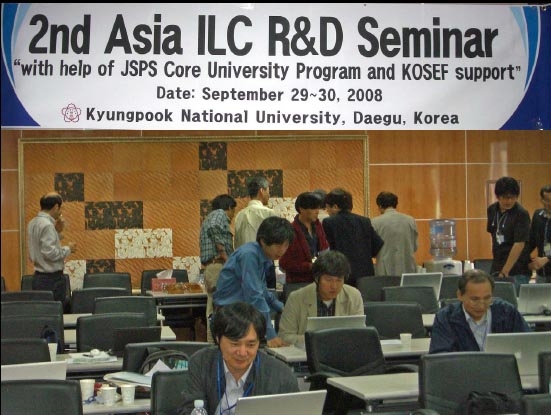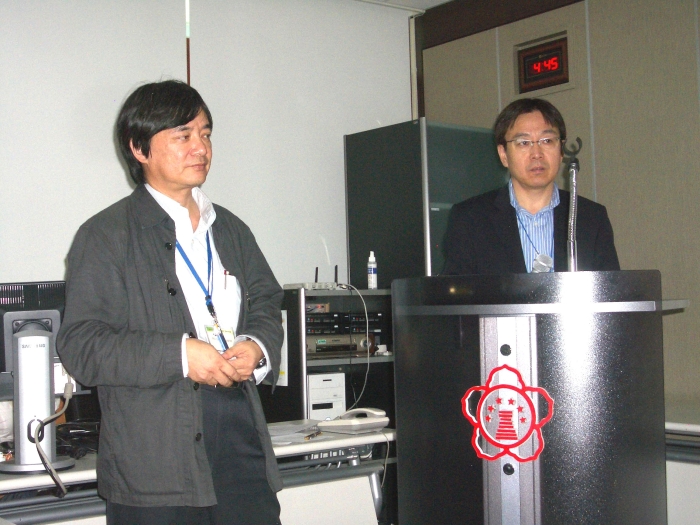Director's Corner
23 October 2008
 Barry Barish |
2nd Asia ILC R&D Seminar
One year ago, I participated in an ILC R&D seminar organised during the China Center for Advanced Science and Technology (CCAST) workshop in Beijing. That successful seminar provided a forum for discussing all the Asian ILC R&D technical work, as well as giving the ILC some visibility in China. I was pleased that a second ILC R&D seminar was being organised in Daegu, Korea at the end of September, and again I agreed to participate. The ILC Global Design Effort is structured around a regional organisation, where we have regional directors, a regionally supported common fund. We rotate our more general meetings between Asian, the Americas and Europe. It is equally important that we carry out coherent regional technical programmes, and regional technical meetings are an important step in that direction.
 The 2nd Asia ILC R&D Seminar The 2nd Asia ILC R&D Seminar |
 Dongchul Son describes the Korean ILC programme Dongchul Son describes the Korean ILC programme |
 Hitoshi Hayano of Japan and Jie Gao of China Hitoshi Hayano of Japan and Jie Gao of China |
The second Asia ILC Seminar was held at Kyungpook National University in Daegu, Korea. Dongchul Son began the meeting with a welcoming address and a comprehensive review of the Korean high-energy physics programme, including a description of the Korean ILC work. Korea is an important partner in our ILC effort that includes accelerator work on bunch compressors, damping rings, superconducting cavities, klystrons and beam position monitors. There is also an active Korean detector programme that includes efforts on silicon trackers, scintillators for calorimetry and a programme developing networking and grid computing.
Korea has been a charter member of the International Linear Collider Steering Committee (ILCSC) and also is a member of the Funding Agencies for the Linear Collider (FALC). I have been in Korea several times in the past few years, but most memorably for the final meeting of the International Technology Review Panel (ITRP) that made the pivotal recommendation to ICFA to base the ILC design on "cold" superconducting radiofrequency (SCRF) technology. That recommendation was accepted and the GDE was formed to carry out the design.
A highlight at the Daegu meeting was a presentation by Jie Gao describing the newly funded ILC SCRF programme of about 15 million yuan (~ 1.5 M€ ) for three years at IHEP in China toward fabrication of a SCRF module with cavity, coupler, tuner, cryostat and low-level RF. The goal is to learn the fabrication technologies and to use it as a horizontal test stand. Hopefully, this is the beginning of a growing dedicated ILC R&D effort in China.
Finally, in conjunction with the Asia ILC seminar, an ATF2 project meeting was held the last day in Korea. I recently wrote about this emerging programme at KEK to demonstrate our ability to make and stabilise small beam spots (around 50 nm). This project is entering into the commissioning phase and we expect important R&D results in the coming year or so.
The Asian region involves at present four separate efforts in Japan, China, Korea and India. The relation between these countries for high-energy physics has no strong unifying mechanism similar to the ones in Europe through CERN and the European Union, nor does it have the close relationships that exist between the big laboratories and the agencies in the Americas. Therefore, it is a challenge for our Regional Director and more generally for us in the GDE to build a coherent regional programme in Asia.
It is unclear whether our present regional organisation will be preserved when the ILC becomes a construction project, but for the R&D phase, we have been organised regionally and we need to make that work as effectively as possible. Technical regional meetings such as the one reported here is an important step in that direction.
-- Barry Barish